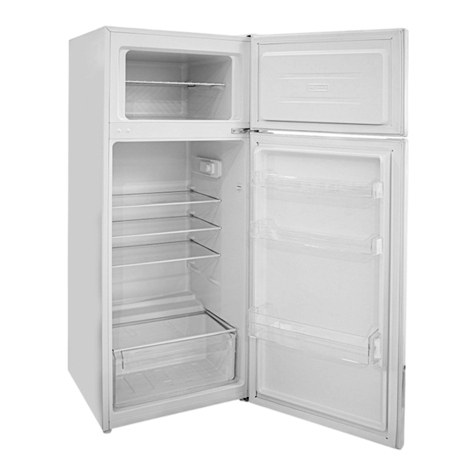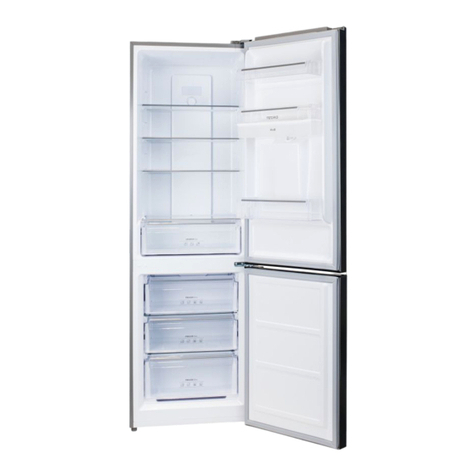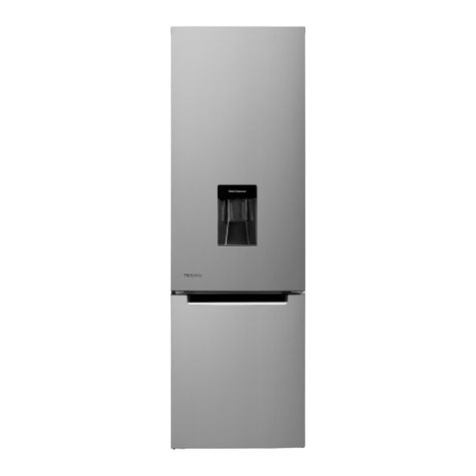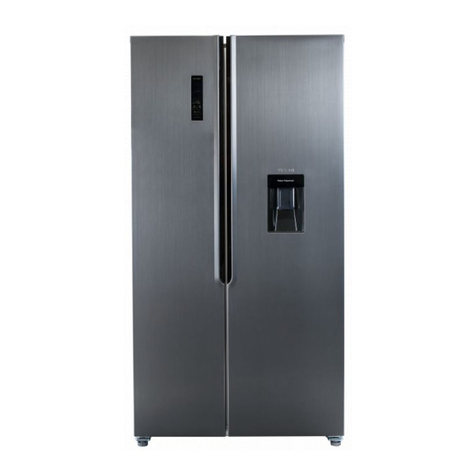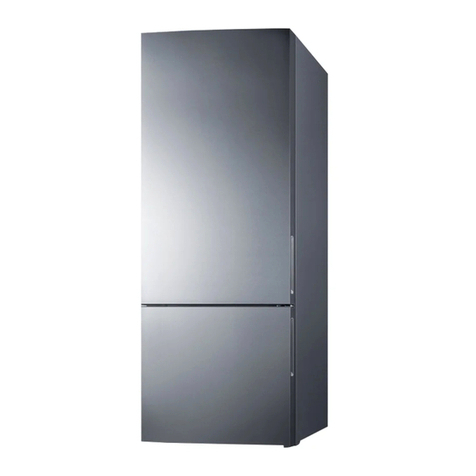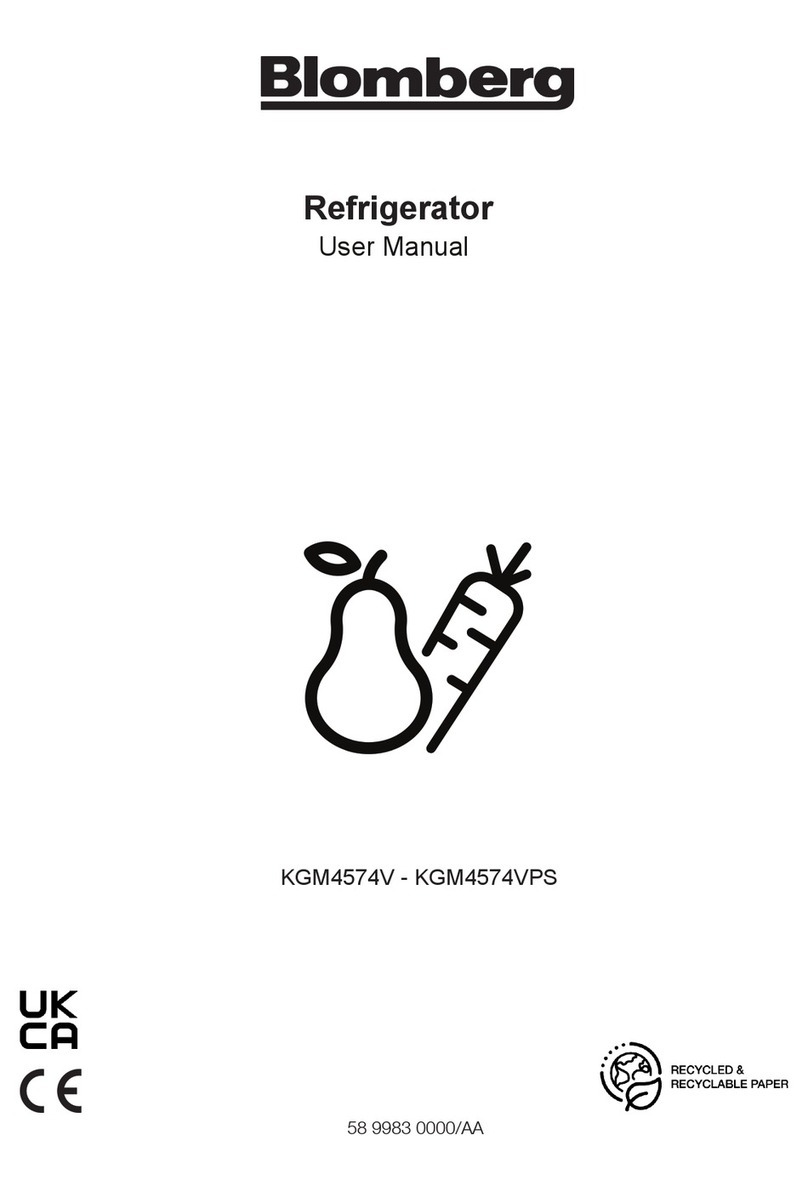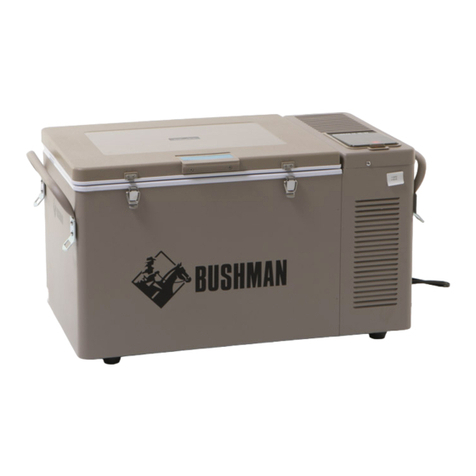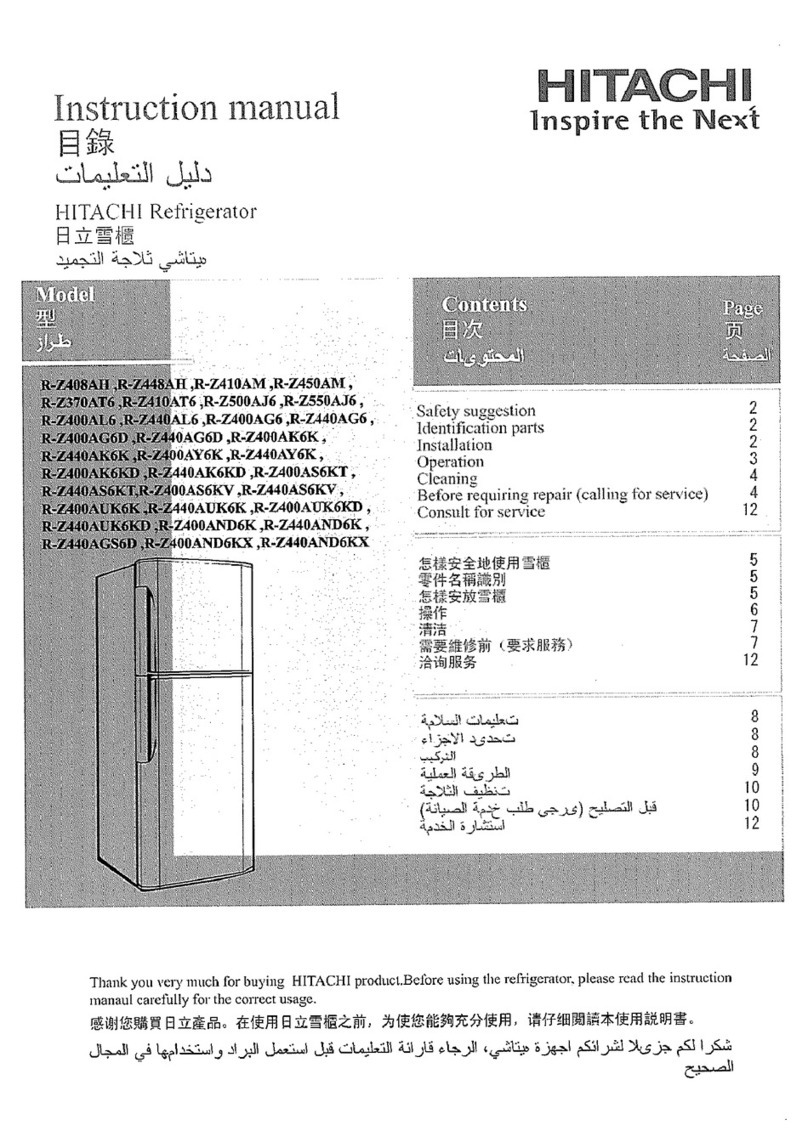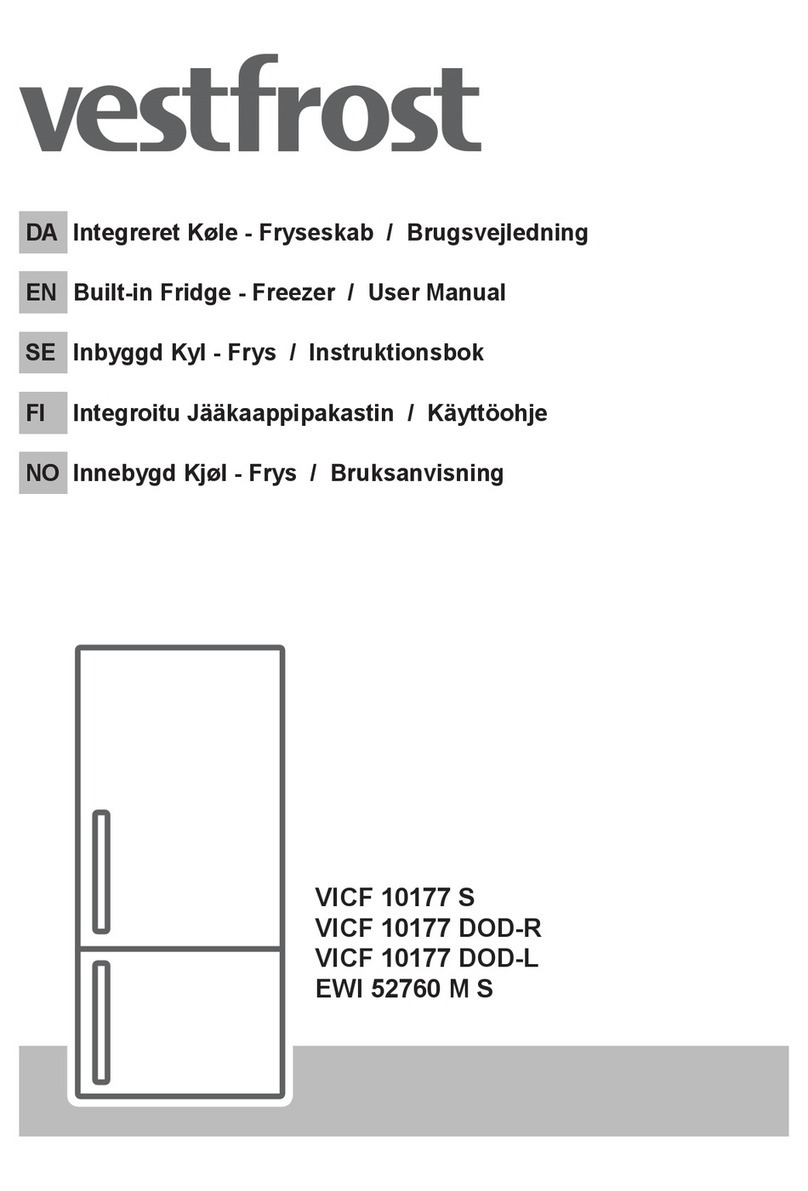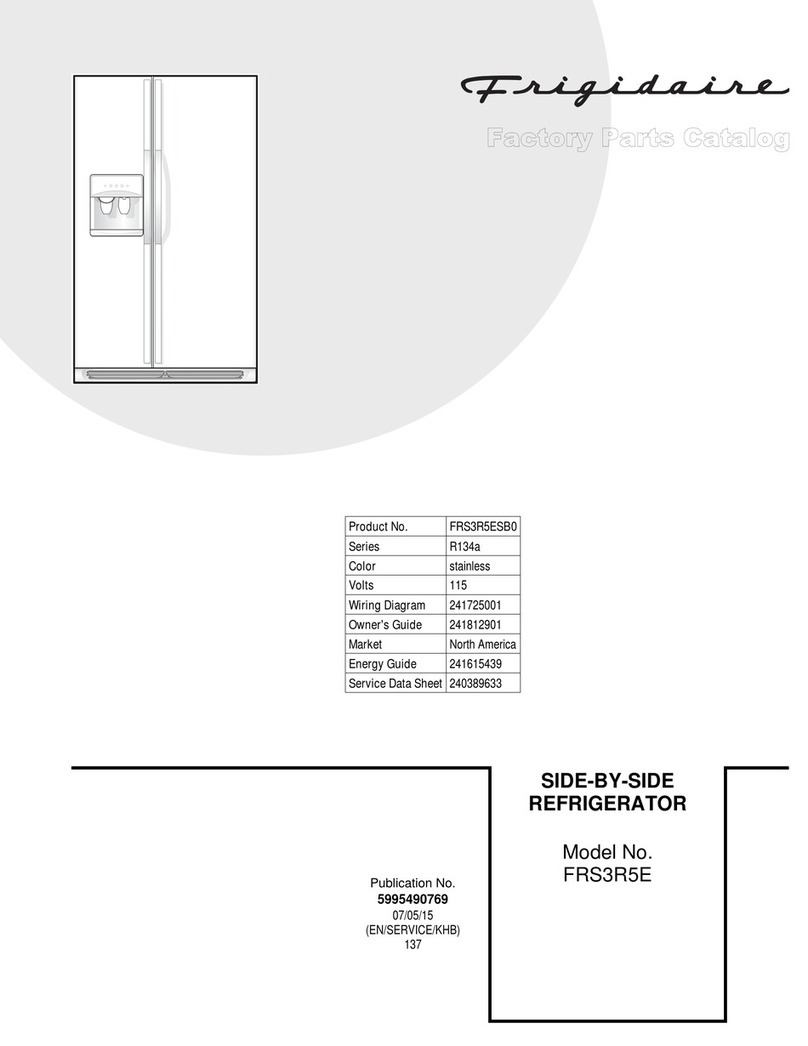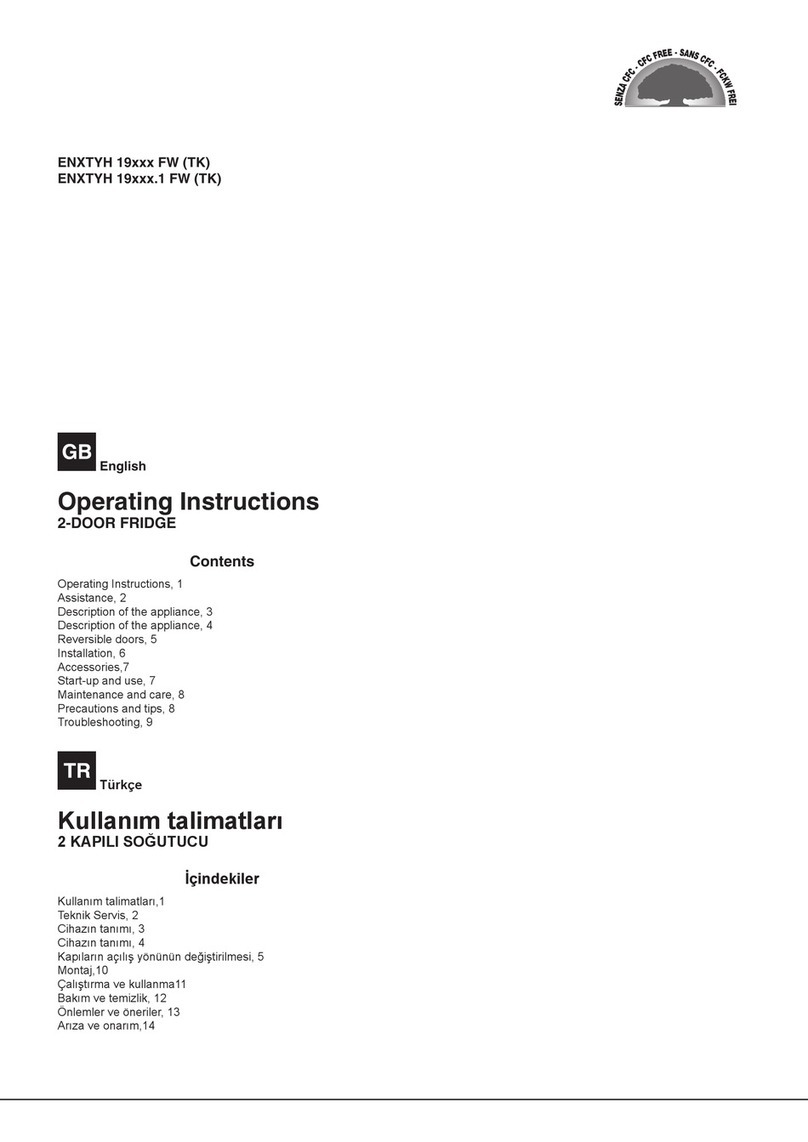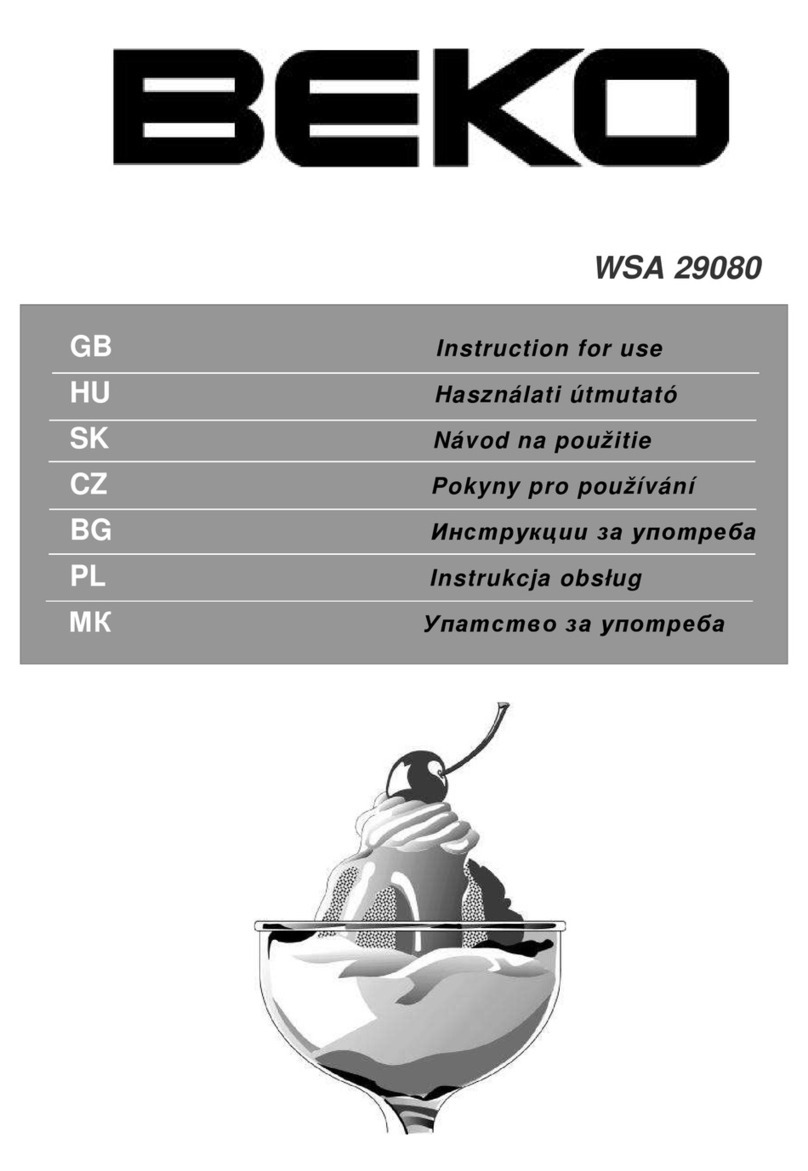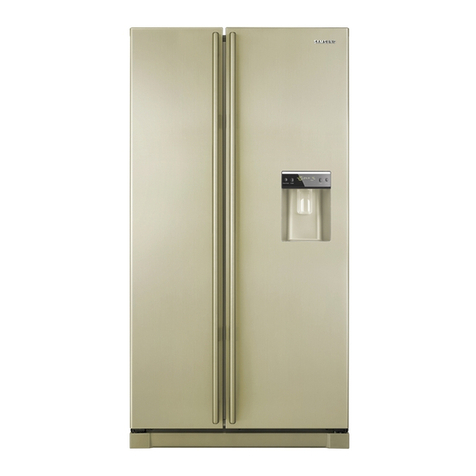TECro PVHS-T1000NB User manual

USER MANUAL /
UPUTE ZA UPORABU
REFRIGERATOR / HLADNJAK
PVHS-T1000NB
Importer for EU / Uvoznik za EU: Pevedžd.d., Savska cesta 84,

USER MANUAL ENGLISH
Content
1. Safety Information Page 1~7
2. Product description Page 8
3. Installation Page 9~10
4. Reverse Door Page 11~14
5. Daily use Page 15~19
6. Troubleshooting Page 20~21
7. Environment Protection Page 22~23

SAFETY INFORMATIONS!
Before first use
In the interest of your safety and toensure the correct
use, before installing and first using the appliance, read
this user manual carefully, including its hints and
warnings. Toavoid unnecessary mistakes and
accidents, it isimportant to ensure that all people
using the appliance are thoroughly familiar with its
operation and safety features.Save these instructions
and make sure that they remain with the
appliance if it is moved or sold, so that everyone
using it through its life will be properly informed on
appliance use and safety. For the safety oflife and
propertykeep the precautions of these user's
instructions as the manufacturer is not
responsible for damages caused by omission.
Children and vulnerable people safety
-Thisappliance can be usedbychildren aged
from 8 years and above and persons with reduced
physical, sensory or mental capabilities or lack of
experience and knowledge if they have been given
super vision or instruction concerning use of the
appliance inasafe way and understand the
hazards involved.
-Children aged from 3 to 8 to years are allowed to
load and unload this appliance.
1

-Children should be supervised toensure that they
donot play with the appliance.
-Leaning and user maintenance shall not be made
by children unless they are aged from 8 years and
above and supervised.
-If you are discarding the appliance pull the plug out of
the socket, cut the connection cable (as close
to the appliance as you can) and remove the door
to prevent playing children to suffer electric
shock or to close themselves into it.
-If these appliance featuring magnetic door seals is
to replace an older appliance having a spring lock
(latch) on the door orlid, besure tomake that sprig
lack unusable before you discard the old appliance.
This will prevent it from becoming a death trap for a
child.
General safety
WARNING! Keep ventilation openings, in the
appliance enclosure or in the built (in structure, clear
of obstruction.
WARNING! Do not use mechanical devices or other
means to accelerate the defrosting process,
other than those recommended by the
manufacturer.
WARNING! Do not damage the refrigerant circuit.
WARNING! Do not use other electrical
appliances such as ice cream makers inside of
refrigerating appliances, unless they are approved for
this purpose bythe manufacture.
2

WARNING! Do not touch the light bulb if it has
been on for a long period of the time could be very hot.
WARNING! When positioning the appliance, ensure
the supply cord is not trapped or damaged.
WARNING! Do not locate multiple portable socket-
outlets or portable power suppliers at the rear of the
appliance.
1.Do not store explosive substance such as aerosol cans
with a flammable propellant in this appliance.
2.The refrigerant isobutene (R-600a) is contained within
the refrigerant circuit of the appliance, a natural gas
with a high level of environmental compatibility, which
is nevertheless flammable.
3. During transportation and installation of the
appliance, be cerain that none of the components of
the relevant circuit become damaged.
-Avoid open flames and sources of ignition
-Thoroughly ventilate the room in which the
appliance is situated
4. It is dangerous to alter the specifications or modify
this product in any way. Any damage to the cord may
cause a short circuit, fire and/or electric shock.
5. This appliance is intended to be usedin house hold
and similar applications such as:
-staff kitchen areas in shops, offices and other working
environments
-farm houses and by clients in hotels, motels and other
residential type of environments
3

-bed and breakfast type of environments
-catering and similar non-retail applications
WARNING! Any electrical componentsplug, power
cord, compressor and etc.must be replaced by a
certified service agent or qualified service personnel.
WARNING! The light bulb supplied with this
appliance is a “special use lamp bulb” usable only
with the appliance supplied. This “special use lamp” is
not usable for domestic lighting.
-Power cord must not be lengthened
-
Make sure that the power plug isnot squashed
or damaged by the back of the appliance.
A squashed or damaged powerplug may overheat
and cause afire.
-Make sure that you can come to the mains plug of the
appliance.
-Do not pull the mains cable
-If the power plug socket is loose, do not insert the
power plug. There is a risk of electric shock or fire.
-You must not operate the appliance without the
lamp.
-This appliance is heavy.Care should be taken when
moving it.
-Do not remove not touch items from the
freezer
compartment if your hands are damp/
wet, as this could cause skin abrasions or frost/
freezer burns.
-Avoid prolonged exposure of the appliance to
direct sunlight.
4

-
Do not put hot on the plastic parts in the appliance.
-
Donot place food products directly against the rear wall
-
Frozen food must not be refrozen once it has been
thawed out.
-
Store pre packed frozen food inaccordance with
the frozen food manufacture, sinstructions
-Appliance, smanufactures storage
recommendations should be strictly adhered to. Refer
to relevant instructions.
-
Do not place carbonated of fizzy drinks in the
freezer compartment as it creates pressure on the
container, which may cause it to explode, resulting in
damage to the appliance.
-
Ice lollies can cause frost burns if consumed straight
from the appliance.
-
To avoid contamination of food, please respect the
following instructions
-
Opening the door for long periods can cause a
significant increase of the temperature in the
compartments of the appliance.
-
Clean regularly surfaces that can come in contact with
food and accessible drainage systems.
-
Clean water tanks if they have not been used for
48h; flush the watersystem connected to a water
supply if water has not been drawn for 5 days.
-
Store raw meat and fish in suitable containers in the
refrigerator, so that it isnotin contact with or drip onto
otherfood.
-
Two-star frozen-food compartments (if they are
presented in the appliance) are suitable for storing pre-
Daily use
5

frozen food, storing or making ice-cream and
making ice cubes.
-One-, two-and three-star compartments (if they
are presented in the appliance) are not suitable for the
freezing of fresh food)
-Ifthe appliance isleft empty for long periods, switch
off, defrost, clean, dry and leave the door open to
prevent mountdevelopingwithintheappliance.
Care and cleaning
-Before maintenance, switch off the appliance and
disconnect the mains plug from the mains socket.
-Do notcleantheappliancewithmetal objects.
-Do not use sharp objects to remove frost from the
appliance. Use a plastic scraper.
-Regularly examine the drain in the refrigerator for
defrosted water. If necessary, clean the drain. If the drain
is blocked, water will collect in te bottom of the
appliance.
Installation
Important! For electrical connection carefully follow the
instructions given in specific paragraphs.
-Unpackthe applianceandcheckifthere are damageson
it. Do not connect theappliance if it is damaged.
Report possible damages immediately to the place you
bought it. In that case retainpacking.
-It is advisable to wait at least four hours before
connecting the appliance to allow the oil to flow back in
the compressor.
6

-Adequate air circulation shouldbe around the
appliance, lacking this leads to overheating. To
achieve sufficient ventilation follow the instructions
relevant toinstallation.
-Wherever possible the spacers of the product should
be against a wall to avoid touching or catching warm
parts (compressor, condenser) to prevent possible
burn.
The appliance must not be located close to radiators
or cookers.
Make sure that the mains plug is accessible after
the installation of the appliance.
Service
-
Any electrical work required to do the servicing
of the appliance should be carried out by a
qualified electrician or competent person.
-
This product must be serviced by an
authorized Service center, and only genuine spare
parts must be used.
Energy saving
-Don'tputhotfoodintheappliance
-Don't pack food close together as thisprevents air-
circulating
-Make sure food don't touch the back of the
compartment(s)
-Ifelectricitygoesoff,don'topenthedoor (s)
-Don'topenthedoor (s)frequently
-Don'tkeepthedoor (s) openfortoolongtime
-Don'tsetthe thermostat on exceedingcold temperatures
-All accessories, such asdrawers, shelves balconies,
should be kept there for lower energy consumption.
7

PRODUCT DESCRIPTION
This illustration is only for hinting, the detail please check your appliance.
Thermostat
and light
Glass Shelves
Crisper cover
Cris
p
er drawer
Door
balconies
Freezer
Leveling feet
8

INSTALLATION
Space Requirement
Keep enough space of door open.
F F
I
F
Levelling the unit
To do this adjust the two levelling feet at front of the unit.
If the unit is not level, the doors and magnetic seal
alignments will not be covered properly.
S
F
9
A500
B560
C8
D
E
F
G855
H
I
Lengthen Shorten

Positioning
Install this appliance at a location where the ambient temperature corresponds to the
climate class indicated on the rating plate of the appliance:
for refrigerating appliances with climate class:
-
extended temperate: this refrigerating appliance is intended to be used at ambient
temperatures ranging from 10 °C to 32 °C; (SN)
-
temperate: this refrigerating appliance is intended to be used at ambient temperatures
ranging from 16 °C to 32 °C;(N)
-
subtropical: this refrigerating appliance is intended to be used at ambient temperatures
ranging from 16 °C to 38 °C;(ST)
-
tropical: this refrigerating appliance is intended to be used at ambient temperatures
ranging from 16 °C to 43°C;(T)
Location
The appliance should be installed well away from sources of heat such as radiators,
boilers, direct sunlight etc. Ensure that air can circulate freely around the back of the
cabinet. To ensure best performance, if the appliance is positioned below an overhanging
wall unit, the minimum distance between the top of the cabinet and the wall unit must be
at least 100 mm. Ideally, however, the appliance should not be positioned below
overhanging wall units. Accurate leveling is ensured by one or more adjustable feet at the
base of the cabinet.
This refrigerating appliance is not intended to be used as a built-in appliance;
Warning!
It must be possible to disconnect the appliance from the
mains power supply; the plug must therefore be easy accessible after
installation.
Electrical connection
Before plugging in ensure that the voltage and frequency shown on the rating plate
correspond to your domestic power supply. The appliance must
be
earthed. The power
supply cable plug is provided with a contact for this purpose. If the domestic power supply
socket is not earthed connect the appliance to a separate earth in compliance with current
regulations consulting a qualified electrician.
The manufacturer declines all responsibility if the above safety precautions are not
observed.
10

S
!
"
#$
) *
$ *
+,!
11

4.
Unscrew bottom hinge of freezer door. Then remove the door
and place it on a soft pad to avoid scratch.
5.
Move door holder from left side to right side.
6. Move
hinge hole cover from left side to right side.
7.
Rotate freezer door and place hinge side at left side.
And
then fix the door by holder.
12

8. Unscrew bottom hinge. Then remove the adjustable feet from
both side.
9. Unscrew and remove the bottom hinge pin, turn the bracket over and replace it.
8. R
efit
the bracket fitting the bottom hinge pin. Replace both adjustable feet.
10.
Place the door back on. Ensure the door is aligned horizontally and vertically so that
the seal are closed on all sides before finally tightening the top hinge. Then inert the
hinge and screw it to the top of the unit.
13

11.
Put the top cover and then screw back.
12. Detach the Fridge and the Freezer door gaskets and then attach them after rotating
.
14

DAILY USE
First use
Cleaning the interior
Before using the appliance for the first time wash the interior and all internal accessories with lukewarm
water and some neutral soap so as to remove the typical smell of a brand new product then dry
thoroughly.
Important!
Do not use detergents or abrasive powders as these will damage the finish.
Temperature Setting
•
Plug on your appliance. The internal temperature is controlled
by a thermostat. There are 8 settings.
1
is warmest setting and
7
is coldest when set is
0
, the appliance is switched off. When
set is max, compressor will not stop
•
The appliance may not operate at the correct temperature if
it is in a particularly hot or if you open the dooroften.
Daily use
P
osition different food in different compartments according to be below table
Refrigerator compartments Type of food
Door and balconies
•
Food with natural preservatives, such as jams, juices, drinks, condiments.
•
Don’t store perishable foods.
Crisper
•
Fruit, herbs and vegetables should be placed separately in the crisper bin.
•
Don't store bananas, onions, potatoes, garlic in therefrigerator.
Fridge shelf
•
Daily products eggs;
•
Foods that do not need cooling, such as ready to eat foods deli meat,
leftovers.
Freezer compartment
•
Foods foe long-term storage.
15

Temperature setting recommendation
Temperature Setting Recommendation
Environment
Temperature
Freezer
compartment
Fridge compartment
Summer /
Set on 2~4
Normal /
Set on 4
Winter /
Set on 4~6
g
Information above give users recommendation of temperature setting.
Impact on Food Storage
g
Under Recommended setting, the best storage time of fridge is no more than 3 days.
g
Under Recommended setting, the best storage time of freezer is no more than 1 month.
g
The best storage time may reduce under othersettings.
16

Freezing fresh food
•
The
freezer
compartment
is
suitable
for
freezing
fresh
food
and
storing
frozen
and
deep
-
frozen
food
for a long time.
•
Place the fresh food to be frozen in the freezer compartment.
•
The maximum amount of food that can be frozen in 24 hours is specified on the rating plate.
•
The freezing process lasts 24 hours) during this period do not add other food to be frozen.
Storing frozen food
When
first
starting
-
up
or
after
a
period
out
of
use
before
putting
the
product
in
the
compartment
let
the appliance run at least $ hours on the higher settings.
Important!
In the event of accidental defrosting for example the power has been off for longer than the
value shown in the technical characteristics chart under “rising time” the defrosted food must be
Consumed q
uickly
or
cooked
immediately
and
then
re
-
frozen
(
after cooked).
Thawing
Deep
-
frozen
or
frozen
food
prior
to
be
used
can
be
thawed
in
the
fridge
compartment
or
at
room
temperature depending on the time available for this operation.
Small pieces may even be cooked still frozen directly from the freezer. In this case cooking will take
longer.
Ice
-
cube
This appliance may be equipped with one or more ice
-
cube to produce ice.
Accessories
Movable shelves
The walls of the refrigerator are equipped with a series of runners
so
that the shelves can be positioned as desired.
Positioning the door balconies
To permit storage of food packages of various sides the door balconies can
be placed at different heights. To make these adjustments proceed as
follows gradually pull the balcony in the direction of the arrows until
it comes free then reposition as required.
17

Helpful hints and tips
To help you make the most of the freezing process here are some important hints;
•
the
ma
ximum
q
uantity
of
food
which
can
be
frozen
in 24 hrs.
is
shown
on
the
rating
pla
te;
•
the freezing process takes 24 hours. No further food to be frozen should be added during this period;
•
only
freeze
top
q
uality
fresh
and
thoroughly
cleaned
foodstuf
fs;
•
prepare food in small portions to enable it to be rapidly and completely frozen and to make it
possible subsequently
to
thaw
only
the
q
uantity
req
uired;
•
wrap up the food in aluminium foil or polythene and make sure that the packages are airtight;
•
do not allow fresh unfrozen food to touch food which is already frozen thus avoiding a
risein temperature of the latter;
•
lean foods store better and longer than fatty ones; salt reduces the storage life of food;
•
water ices if consumed immediately after removal from the freezer compartment can possibly
cause the skin to be freeze burnt;
•
it is advisable to show the freezing in date on each individual pack to enable you removal
from the freezer compartment can possibly cause the skin to be freezeburnt;
•
it is a dv isable to show the freezing in d ate on each indi vidual pack to enable yo u to kee p
tab of the storage time.
Hints for storage of frozen food
To obtain the best performance from this appliance you should:
•
mak
e
sure
that the
commercially
frozen
foodstuffs
were
adequately
stored
by
the
reta
iler;
•
be sure that frozen foodstuffs are transferred from the food store to the freezer in the shortest
possible time;
•
not
open
the
door
frequently
or
lea
ve
it
open
longer
than
absolutely
necessary.
•
once
defrosted
food
deteriorates
rapidly
and
cannot
be
re-
frozen;
•
do not exceed the storage period indicated by the food manufacture.
Hints for fresh food refrigeration
To obtain the best performance:
•
Do
not
store
warm
food
or
ev
aporating
liquids
in
the
refrigerator
•
Do cover or wrap the food particularly if it has a strong flavor
•
Make (all types) wrap in polythene bags and place on the glass shelves above the vegetable drawer.
•
For safety store in this way only one or two days at the most.
•
Cooked foods cold dishes etc...: these should be covered and may be placed on any shelf.
•
Fruit and vegetables: these should be thoroughly cleaned and placed in the special drawer(s) provided.
•
butter and cheese: these should be placed in special airtight containers or wrapped in
aluminum foil or polythene bags to exclude as much airas possible.
•
Oil bottle: these should have a cap and should be stored in the balconies on the door.
•
Bananas potatoes onions and garlic if not packed must not be kept in the fridge.
Cleaning
For hygienic reasons the appliance interior including interior accessories should be cleaned regularly.
Caution! The appliance may not be connected to the mains during cleaning. Danger of a
electrical shock! Before cleaning switch the appliance off and remove the plug from the
mains or switch off or turn out
the circuit breaker or fuse. Never clean the appliance with a steam
cleaner. Moisture could accumulate in electrical components danger of electrical shock! Hot vapors
can lead to the damage of plastic parts. The appliance must be dry before it is placed back into
service.
Important!
Ethere
al
oils
and
organic
solvents
can atta
ck
plastic
parts e.g.
lemon
ju
ice
or
the juice
form
orange peel butyric acid cleanser that contain acetic acid.
18
Table of contents
Other TECro Refrigerator manuals
